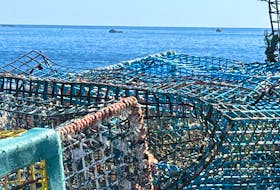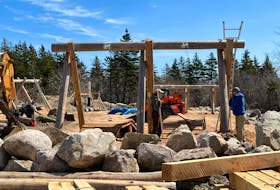KENTVILLE – Until recently, Jon Saklofske would have assumed raccoons were to blame whenever it seemed a critter raided his compost bin in the wee morning hours.
That theory changed when he came face-to-face with the real culprit July 8.
“At four in the morning this past Saturday our dogs (a mini poodle and a mini dachshund) started barking like they often do if they have to go to the bathroom and can't wait until we get up. As I let them out, they both paused in a funny way,” said Saklofske in an e-mail July 10.
“They went outside and the poodle (Coco) went to the right, around the corner of the garage into the darkness by the compost bin. A few seconds later, he let out a super loud series of barks and howls and started to chase something into the front yard.”

The Kentville resident called for the small dog to return as Coco’s barks could be heard getting more distant.
“I heard his bark again, nearer, called out again and saw a white shape in the darkness running back towards the house. Relieved, I took the dogs inside and went back to bed,” he said.
The family awoke the following morning to discover that something had knocked the two cinderblocks placed on the lid of the compost cart off, tipped the bin stored outside of their MacDonald Park Drive home over and scattered the contents on the ground.
“We went out for the day, and when we came home, somebody from the Department of Natural Resources (DNR) had come (and) left a pamphlet in our mailbox about bears being sighted in our area,” he said.
“So as far as we can figure out, Coco, the little poodle, must have scared and chased this black bear out of our yard at 4 a.m.”
This theory seemed increasingly plausible following the events that unfolded the next evening.
“On Sunday night the bear came back. I heard things bashing around outside just after midnight, looked out the window and was face to face with a five-foot long black bear who was batting around our overturned compost bin,” recalled Saklofske.
“I called the Kentville Police to report the sighting, and they sent out two officers within five minutes.”
The officers scanned the perimeter of the property, but the bear was not located.
“After the collection we're planning to wash out the compost bin with a bleach and water mixture as advised by the DNR pamphlet and keep it in the garage. We're also going to put our compost in our deep freezer for the next two weeks,” said Saklofske.
“Hopefully in that time the bear forgets that our house is a potential source of food.”
Sightings elsewhere in Kings
Bear sightings have hardly been isolated to the Town of Kentville this summer.
Aylesford resident Nancy Sills has heard of multiple sightings in the western end of the county, including two on her own property in a small subdivision along Ernst Drive.
The first, on Canada Day, occurred in broad daylight. Sills was standing outside and a neighbour passing by stopped to tell her that a bear was in her backyard. He advised her to grab her dog, a doodle, and go inside.
“It’s so new for us. I’ve lived here since 2006 and I’ve certainly never seen a bear,” said Sills.
“I’ve lived in N.S. for 30 years and I’ve never seen a bear in the wild.”
Four days later, Sills woke up to her doodle letting out a low, grumbling growl and barking around 4:30 a.m. She flicked on the exterior lights and started peering out of her windows to see if the bear had returned to her yard.
“Just as I’m giving up I go to the front of the house and flick on the light and… he’s coming along the walkway to my front door,” she recalled.
The bear walked past the door and continued down the street, eventually disappearing into the darkness.
“At the time was quite freaky for me,” said Sills.
“Some of the neighbours are concerned because they have small children.”
Sills reported the sighting to DNR and received some advice on how to respond to the bear’s presence on her property, which backs onto a wooded area.
“The green bins are just great big lunchboxes to them… we think that they’re in our neighbourhood but really we’re in theirs,” she said.
“I’m not scared but I’m careful now. Every time I come outside I check the woods, I check around the house – I’m more aware of the surroundings and I don’t let my dog out alone at night.”
Sills said the bear’s visit was certainly unexpected, but she’s heard of a few sightings in the area this summer, including one on the Hall Road and another on Glebe Road.
Her friend, Sandra Behan Matthews, captured a video of a black bear casually strolling down the driveway of her home along Highway 201 in Greenwood Square around 1 a.m. July 7, presumably making its way to their bird feeders.
“We were actually shocked to see the bear when we checked our security camera, we figured it was a raccoon that trashed our bird feeders. We keep our garbage locked up and we now bring our feeders in at night. It is kind of scary to think that there is a bear in the area and so close,” said Behan Matthews.
Reporting sightings, prevention tips
The Kentville Police Service spread word of the bear sighting on MacDonald Park Drive, and in backyards of other homes in that area, with a Facebook post July 9.
“It appears the bear is being attracted by residential green bins. A reminder for residents to be aware of your green bin location,” the post reads.
Residents are advised to contact their local police service and DNR in the event of a sighting, the post adds.
As of July 10, Insp. Darryl Brown said the Kentville Police Service had received “no further reports” of bear sightings.
Const. Kelli Gaudet of the Kings District RCMP said there have been a few reported sightings, and residents looking for tips on how to respond to news that bears have been seen in their area are encouraged to contact DNR.
DNR spokesperson Bruce Nunn noted that bears are more likely to be spotted at this time of year.
“It is the time of year that young bears are more evident as they search for food sources, so sightings are typically on the rise in the summer months. Not all bear sightings are reported to our department, but many people see bears in Nova Scotia at this time of the season,” he said.
The are some steps residents can take to make their properties less appealing to bears in search of a meal.
“Our biologists point out that if bears are coming around your yard, they are seeking a food source and may be attracted by the smells of compost, garbage, or pet food in outdoor feeding dishes. It is important to ensure those things are put away in a shed or garage, so bears do not have access,” said Nunn.
“Removing birdseed from feeders is also a good step to discourage bears from coming around.”
DNR’s website lists green carts, garbage containers, garden compost, bird feeders, barbecues, pet food bowls and fruit trees as examples of things that attract bears, and offers some tips on how to keep bears away.
Browse through bear facts, learn what to do if you’ve spotted a bear or read more about what attracts bears to residential properties by visiting https://novascotia.ca/natr/wildlife/living-with-wildlife/bear/
Fast facts about black bears in Nova Scotia
- Black bears are omnivores capable of smelling food more than 1 kilometre away.
- It is the only species of bear in Nova Scotia, typically living 12 years and weighing 100 to 440 pounds.
- Cubs are born in January and February and remain with the mother for one year.
- These bears excel at swimming and can run at speeds of up to 56 km/hr for short distances.
- Problematic bears are often young and new to being out in the wild on their own.
Source: https://novascotia.ca/natr/wildlife/living-with-wildlife/bear








